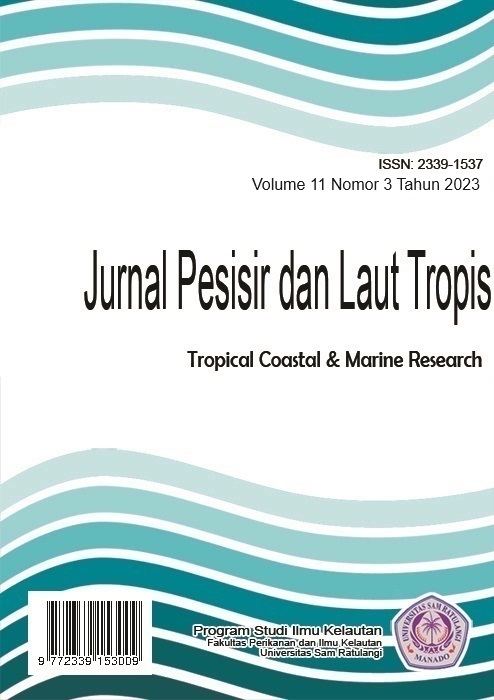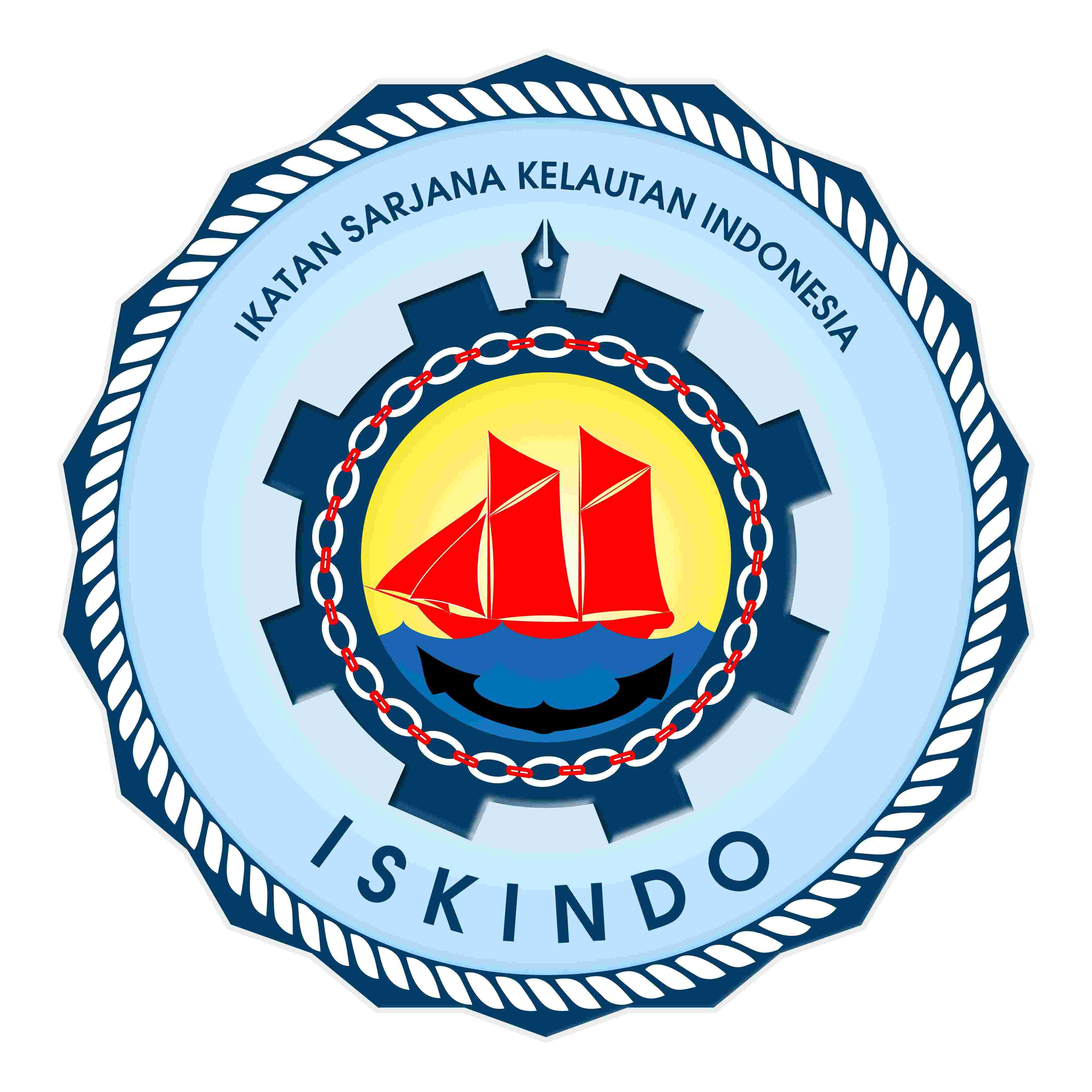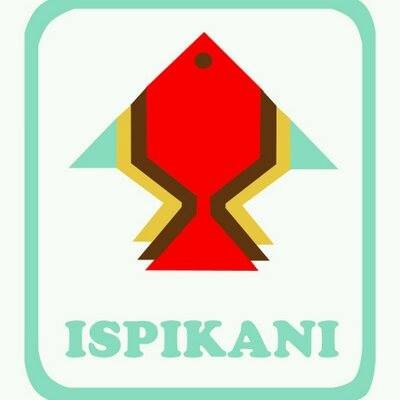IDENTIFIKASI MOLEKULER SPESIES MIKROBA FOTOSINTETIK YANG BERASOSIASI DENGAN ASCIDIACEA DI TELUK MANADO
DOI:
https://doi.org/10.35800/jplt.11.3.2023.54003Keywords:
Ascidia; Mikroba;16S rRNA; Prochloron sp.Abstract
The objective of this study was to molecularly determine the microbial species. The isolation of microbes from their hosts was conducted by squeezing the tissues that contain green suspension. The suspension was then kept in a freezer until DNA isolation. DNA isolation was performed with standard procedur, following with PCR amplification using universal primer pair for 16S rRNA gene. PCR products were then sequenced, and the results was aligned with the relevant data in NCBI (National Center for Biotechnological Information) web using BLAST (Basic Local Alignment Search Tool). Among the five ascidian species, only one species, Diplosoma virens that its microbial suspension with sample identity, E1 was molecularly identified. PCR product of its 16S rRNA gene was 1150 bp in length. Alignment of this sequence with the relevant sequences in NCBI using BLAST resulted in the range of similarity of 99.40 – 100% with the 16S rRNA sequences of 17 samples described as Prochloron sp., where their hosts were of different species and from different locations, except for sample with accession number of MT 254065. This sample was described as Prochloron didemni IMFR-1 in NCBI was originated from Lissoclinum patella in Manado Bay. However, the 16S rRNA sequence of E1 sample of this study was 100% similarity with the Uncultured Prochloron sp. clone E11-016 that was from different species of host and location. Therefore, Prochloron didemni was non obligate symbiont microbe that could associate with different ascidian species.
Keywords: Ascidian, Microbe, 16S rRNA, Prochloron sp.
ABSTRAK
Tujuan penelitian ini adalah untuk mengetahui jenis mikroba secara molekuler. Isolasi mikroba dari inang ascidia dilakukan dengan cara memencet jaringan inang yang berisi suspensi warna hijau. Suspensi yang diperoleh, disimpan beku sampai saatnya isolasi DNA. Isolasi DNA dengan prosedur standar, kemudian diamplifikasi menggunakan primer gen 16S rRNA. Produk PCR kemudian disekuens, dan hasil sekuensnya diselaraskan menggunakan BLAST (Basic Local Alignment Search Tool) yang ada di di laman NCBI (National Center for Biotechnological Information). Dari 5 jenis ascidia yang diisolasi mikrobanya, ternyata hanya suspensi dari Diplosoma virens dengan identitas sampel E1 yang teridentifikasi secara molekuler. Produk PCR ini berukuran 1150 bp yang hasil sekuensnya ketika dicocokkan menggunakan BLAST pada data sejenis di NCBI, mempunyai kemiripan 99,40 – 100% dengan sekuens gen yang sama pada 17 sampel yang terdeskripsikan sebagai Prochloron sp. di NCBI dengan inang dan lokasi yang berbeda dengan penelitian ini, kecuali sampel dengan aksesi MT 254065. Sampel ini terdeskripsi sebagai Prochloron didemni IMFR-1 yang sampelnya diisolasi dari ascidia Lissoclinum patella dari lokasi yang sama dengan penelitian ini. Namun sampel E1 justru mirip 100% dengan Uncultured Prochloron sp. clone E11-016 yang diisolasi dari inang dan lokasi berbeda. Jadi Prochloron didemni merupakan mikroba simbion non obligate yang dapat berasosiasi dengan jenis-jenis inang yang berbeda.
Kata Kunci: Ascidia, Mikroba,16S rRNA, Prochloron sp.
References
Ngantung, A., Bara, R., A., Sumilat, D. 2016. Uji Aktivitas Antibakteri dari Spons Dictyonella funicularis dan Phyllospongia lamellosa yang Diambil pada Perairan Bunaken. Jurnal Pesisir dan Laut Tropis, 4(2), 10-16.
Behrendt, L., Larkum, A.W.D., Trampe, E., Norman, A., Sorensen, S. J., Kuhl, M. 2012. Microbial Diversity of Biofilm Communities in Microniches Associated with the Didemnid Ascidian Lissoclinum patella. The ISME Journal, 6, 1222-1237.
Colin, P.L., Arneson, C. 1995. Tropical Pacific Invertebrates. A Field Guide to the Marine Invertebrates Occurring on Tropical Pacific Coral Reefs, Seagrass Beds and Mangroves. Coral Reef Press. Beverly Hills,CA,USA. p 296.
Hirose, E., Turon, X., Lopez-Legentil, S., Erwin, P.M., Hirose, M. 2012. First Records of Didemnid Ascidians Harbouring Prochloron from Caribbean Panama: Genetic Relationships Between Caribbean And Pacific Photosymbionts And Host Ascidians. Systematics and Biodiversity, 10(4), 435-445.
Lin, Z., Torres, J.P., Tianero, M.D., Kwan, J. C., Schmidt, E. W. 2016. Origin of Chemical Diversity in Prochloron-Tunicate Symbiosis. Applied and Environmental Microbiology, 82(12), 3450–3460.
Malintoi, A., Rumengan I.F.M., Roeroe, K. A., Warouw, V., Rondonuwu, A.R., Ompi, M. 2020. Komunitas Ascidia di Pesisir Malalayang Dua, Teluk Manado, Sulawesi Utara. Jurnal Pesisir dan Laut Tropis, 8(1), 39-46.
Münchhoff, J., Hirose, E., Maruyama, T., Sunairi, M., Burns, B. P., Neilan, B. A. 2007. Host Specificity and Phylogeography of the Prochlorophyte Prochloron sp., an Obligate Symbiont in Didemnid Ascidians. Environmental Microbiology, 9(4), 890–899.
Ostell, J.M., Wheelan, S.J., Kans, J.A. 2001. The NCBI Data Model. Methods of Biochemical Analysis, 43, 19–43.
Rumengan, I.F.M., Roring, V.I.Y., Haedar, J.R., Siby, M.S., Luntungan, H.A., Kolodam, J.B., Uria, R.A., Wakimoto, T. 2021. Ascidian-Associated Photosymbionts from Manado, Indonesia: Secondary Metabolites, Bioactivity Simulation, and Biosynthetic Insight. Symbiosis, 84(1),1-12.
Sumilat, D. A., Palit, C., Opa, S. L., Ompi, M,. 2022. Ascidia dari Sulawesi Utara. Bandung. 74 hal.
Tomitani, A., Okada, K., Miyashita, H., Matthijs, H.C., Ohno, T., Tanaka, A. 1999. Chlorophyll b and Phycobilins in the Common Ancestor of Cyanobacteria and Chloroplasts. Nature, 400(6740),159-162.
Untu, P., Rumengan, I.F.M., Ginting, E. 2015. Identifikasi Mikroba yang Koeksis dengan Ascidia Lissoclinum patella Menggunakan Sekuens Gen 16S rRNA. Jurnal Pesisir dan Laut Tropis, 3(2), 23-33.
Urbach, E, Robertson L.D, Chisholm. W.S. 1992. Multiple Evolutionary Origins of Prochlorophytes within the Cyanobacterial Radiation. Nature, 355(6357), 267-269.
Downloads
Published
How to Cite
Issue
Section
License

This work is licensed under a Creative Commons Attribution-NonCommercial 4.0 International License.
















